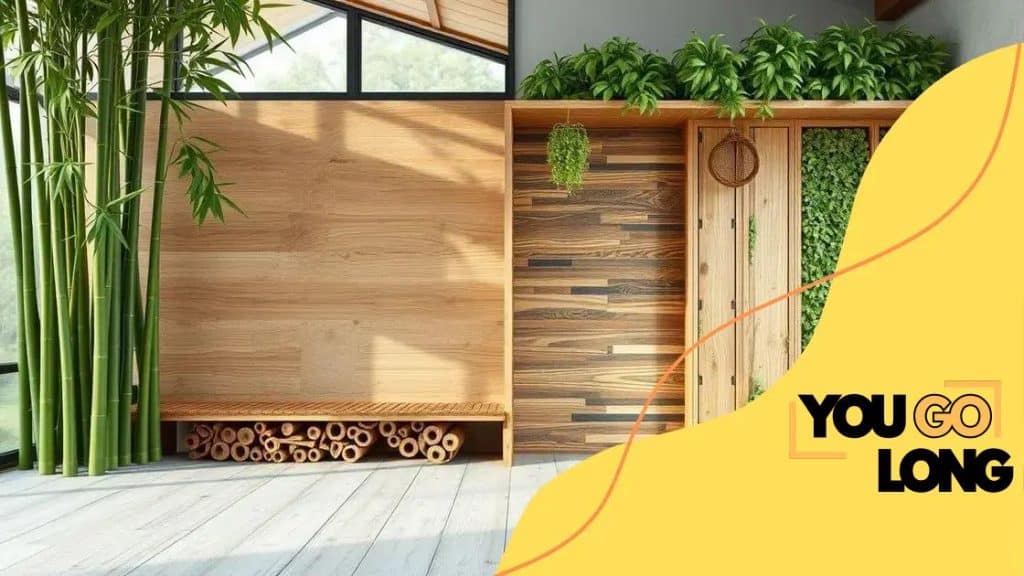Sustainable building materials for eco-friendly homes

Advertisement
Sustainable building materials significantly reduce environmental impact by conserving resources, minimizing waste, and enhancing energy efficiency, making them essential for eco-friendly home design.
Sustainable building materials for eco-friendly homes are becoming increasingly important as we seek healthier living environments. Have you ever wondered how these materials can benefit both you and the planet? Let’s dive into the exciting options out there.
Benefits of using sustainable building materials
Using sustainable building materials has numerous advantages that not only benefit homeowners but also the environment. When we choose these materials, we contribute to a healthier planet and enjoy unique benefits in our living spaces.
Environmental Impact
First and foremost, one of the most significant benefits is the reduced environmental impact. Sustainable materials are often sourced responsibly and are designed to minimize waste. By using them, you can lead efforts towards conservation and biodiversity.
Advertisement
Health Benefits
Furthermore, many sustainable materials promote better indoor air quality. They are typically free from toxic chemicals and volatile organic compounds (VOCs), which can negatively affect your health.
- Bamboo: A rapidly renewable resource that is strong and stylish.
- Recycled materials: Using refurbished products cuts down on waste.
- Natural insulation: Fiber-based options like sheep’s wool keep your home warm.
Additionally, sustainable building materials can improve energy efficiency. For instance, products like high-performance windows or solar panels can significantly reduce energy costs and carbon footprints.
Long-Term Savings
Investing in these materials may seem costly at first, but they often lead to long-term savings. Due to their durability and energy efficiency, they can lower maintenance and utility expenses over time.
Advertisement
This means that sustainable building materials not only protect the environment but also contribute to your financial well-being. Choosing them is a smart and forward-thinking decision. By making conscious choices, we can all create a better future.
Types of sustainable materials available
When considering sustainable building materials, it’s essential to explore the various types available. These materials not only contribute to eco-friendliness but also enhance the aesthetic appeal and durability of your home.
Wood Alternatives
First, alternatives to traditional wood can be an excellent choice. Products like bamboo and reclaimed wood are popular. Bamboo grows quickly, making it a renewable resource, while reclaimed wood saves existing trees and adds character to new constructions.
Natural Insulation
Another significant category is natural insulation. Options like sheep’s wool and hemp are not only effective at regulating temperature but also safe for the environment. These materials improve energy efficiency and keep your home comfortable throughout the year.
- Straw bales: They are excellent insulators and sustainable.
- Cork: This renewable resource is great for floors and walls.
- Cellulose: Made from recycled paper, it’s an effective insulation material.
Another interesting category is biocomposite materials. These are made from a mix of natural fibers, like flax or sisal, and biopolymers. They are lightweight, strong, and have a variety of uses in construction and design.
Recycled Materials
Recycled materials have gained popularity for their sustainability. Products like recycled aggregate and glass tiles reduce waste and create unique design elements. Using such materials not only conserves resources but also supports the circular economy.
Incorporating these sustainable materials into your building project is a fantastic way to contribute to environmental stewardship while enhancing your living space. The variety of available options means there is something for every style and budget.
How to choose the right materials for your home

Choosing the right sustainable building materials for your home can be an exciting yet challenging task. With so many options available, it’s crucial to consider what’s best for your specific needs and values.
Assess Your Needs
First, assess your needs. Think about the purpose of your building project. Are you constructing a new home or renovating? Will you require materials for framing, insulation, or finishing touches? Understanding your needs helps narrow down your choices.
Consider the Environment
Next, consider the environmental impact of your selections. Look for materials that are either renewable or recycled. This step helps ensure that your choices contribute positively to the planet while still meeting your goals.
- Local sourcing: Choose materials that are sourced locally to reduce carbon emissions from transportation.
- Durability: Select materials that will stand the test of time, minimizing the need for replacements.
- Energy efficiency: Look for materials that improve energy performance, such as high insulation value components.
It’s also important to evaluate the aesthetic appeal of the materials. Consider how different options blend with your overall design. The right materials should not only be functional but also enhance the beauty of your home.
Cost vs. Long-Term Value
When selecting materials, balance initial costs with long-term value. While some sustainable materials may come with a higher price tag, they can lead to savings in energy bills and maintenance over time. Think of the benefits they provide for both your wallet and the environment.
Finally, consult with professionals if needed. Architects or contractors experienced in sustainable design can offer valuable insights and guidance. This collaboration can ensure that your selections align with your goals and lead to a successful outcome in your project.
The impact of sustainable materials on the environment
The impact of sustainable materials on the environment is significant and far-reaching. These materials play a crucial role in reducing pollution and conserving natural resources.
Resource Conservation
First, using sustainable materials helps conserve vital resources. For example, materials like bamboo grow quickly and can be harvested without causing lasting damage to the ecosystem. By choosing these resources, we ensure that future generations have access to the materials they need.
Reduction of Waste
Additionally, opting for recycled materials reduces waste. This practice minimizes the amount of trash sent to landfills and encourages a circular economy. Items like recycled glass or reclaimed wood not only divert waste but also require less energy to produce than new materials.
- Lowered carbon emissions: Sustainable materials typically require less energy to manufacture.
- Enhanced biodiversity: Their use often supports eco-friendly practices that protect habitats.
- Pollution reduction: By choosing non-toxic materials, we keep harmful substances out of our environment.
Sustainable materials also contribute to better air and water quality. For instance, using natural insulation like sheep’s wool prevents the release of harmful chemicals often found in synthetic products. This choice leads to healthier living environments.
Climate Change Mitigation
Moreover, the use of sustainable building materials is essential in the fight against climate change. They help lower greenhouse gas emissions by reducing reliance on fossil fuels and enhancing energy efficiency in buildings. Materials like solar panels and high-efficiency windows generate renewable energy and reduce the overall carbon footprint of homes.
By understanding the impact of sustainable materials on the environment, we can make informed decisions that promote a healthier planet. Our choices today pave the way for a sustainable and thriving tomorrow.
Tips for incorporating sustainability in home design
Incorporating sustainability in home design is a rewarding journey. By making thoughtful choices, you can create a living space that is both beautiful and environmentally friendly.
Plan for Energy Efficiency
One of the best ways to start is by planning for energy efficiency. This means selecting appliances that use less energy and installing energy-efficient windows. These windows can help keep your home warm in winter and cool in summer, reducing heating and cooling costs.
Choose Sustainable Materials
Another essential tip is to choose sustainable materials. Look for recycled, biodegradable, or locally sourced options. For example, bamboo flooring is a great choice as it is renewable and stylish. Additionally, using reclaimed wood for furniture or accents adds character while helping to reduce waste.
- Use eco-friendly paints: These paints have fewer volatile organic compounds (VOCs) and improve indoor air quality.
- Install a green roof: This can help manage stormwater and improve insulation.
- Utilize natural light: Design large windows or skylights to maximize daylight and reduce reliance on artificial lighting.
Incorporating plants into your design not only beautifies your home but also improves air quality. Indoor plants can help purify the air and create a soothing environment. Additionally, consider landscaping with native plants outside. These plants require less water and care, making them a smart choice for sustainability.
Optimize Water Usage
Water efficiency is another critical aspect of sustainable design. Invest in low-flow fixtures and appliances that conserve water. Rainwater harvesting systems can collect precipitation for use in irrigation, further reducing your water footprint.
Finally, think about the home’s overall footprint and site impact. Design your home to minimize land disturbance and protect existing trees and habitats. By considering these elements, you will create a home that is not only sustainable but also a beautiful sanctuary for you and your family.
FAQ – Frequently Asked Questions about Sustainable Building Materials
What are sustainable building materials?
Sustainable building materials are products that are sourced, manufactured, and used in a way that reduces environmental impact. They include recycled, renewable, and non-toxic materials.
Why should I consider sustainable materials for my home?
Using sustainable materials helps reduce energy consumption, minimize waste, and create healthier living environments, contributing positively to the planet.
How can I make my home more energy-efficient?
You can improve energy efficiency by using energy-efficient windows, installing proper insulation, and selecting appliances that consume less electricity.
What plants are best for indoor air quality?
Some great indoor plants for improving air quality include spider plants, snake plants, and peace lilies. They help purify the air and add a natural touch to your home.





